

DIY: Upside-Down Hanging Herb Garden. At some point near the middle of March, I always decide that I’m “done” with winter.

The sweaters and jackets get pushed to the back of the closet, the flip flops come out, and I inevitably freeze my butt off for several weeks until the weather catches up with my warm-weather state of mind. Likewise, my cravings for fresh herbs and veggies are always a little ahead of the season. 5 Best Container Gardening Ideas From 2013. December 31st, 2013 Email 8 users recommend EZ-walls Plant Protectors, planted with short-season tomatoes, were the best way to get a head start on the garden.
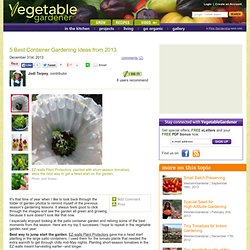
Jodi Torpey The container garden enjoyed time spent in the plastic pool while I was on vacation. Best of tomatoes from 2013 included 'Tiny Tim' (upper left), 'White Cherry' (middle left) and 'Sungold' (bottom). How To Protect Containers In The Winter. By Marion Owen, special to HGTV.com I sleep and garden in Alaska, a state so vast you can fill it with two Californias, one Texas and top it off with a New Jersey maraschino.

Dozens of containers dot my property on Kodiak Island. They're home to perennials, herbs, fruit trees, berry vines, roses and birch trees. For the most part, northern gardeners chuckle at being assigned climate zones, which are generalizations at best. It's like saying ice cream only comes in vanilla. One of the easiest ways to give containers winter protection is to simply move them into an unheated garage or shed, preferably where temperatures stay above freezing. If you don’t have an unheated protected space, you can leave your containers outside. Rita Jo Shoultz, owner of Fritz Creek Gardens in Homer, Alaska, shaves a step. Top 10 NASA Approved Air Quality Houseplants. The 16 Best Healthy, Edible Plants to Grow Indoors. From farmers’ markets and Community Supported Agriculture, to urban farms and rooftop gardens, to produce delivery services, more and more people across the U.S. are embracing farm-fresh food.
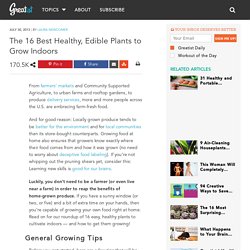
And for good reason: Locally grown produce tends to be better for the environment and for local communities than its store-bought counterparts. Growing food at home also ensures that growers know exactly where their food comes from and how it was grown (no need to worry about deceptive food labeling). If you’re not whipping out the pruning shears yet, consider this: Learning new skills is good for our brains. Growing Mushrooms In My Hall Cupboard. 17 Apart: Growing Celery Indoors: Never Buy Celery Again.
Remember when we tested and shared how to grow onions indefinitely last week?

Well, at the same time, we've been testing out another little indoor gardening project first gleaned from Pinterest that we're excited to share the successes of today — regrowing celery from it's base. We've figured out how to literally re-grow organic celery from the base of the bunch we bought from the store a couple weeks ago. I swear, we must have been living under a rock all these years or just not be that resourceful when it comes to food, but we're having more fun learning all these new little tips and tricks as we dive deeper into trying to grow more of our own food.
This project is almost as simple as the onion growing project — simply chop the celery stalks from the base of the celery you bought from the store and use as you normally would. In our case, we had a particular homemade bean dip that needed sampling! Ideas For The Easiest Garden On Earth. Grow Fresh Vegetables Year Round Without A Garden. Did you know that you can have a source of fresh vegetables that are available all year long without the need of a grocery store or garden?
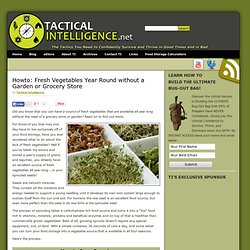
Read on to find out more… For those of you that may one day have to live exclusively off of your food storage, have you ever wondered what to do about the lack of fresh vegetables? Well if you’ve taken my advice and stored a year’s supply of grains and legumes, you already have an excellent source of fresh vegetables all year long – in your sprouted seeds! Seeds are nature’s miracles. Ways To Create More Growing Space. By Cindy Naas The biggest challenge any urban gardener faces is that of finding enough room to grow everything.

66 Things To Grow At Home: In Containers, Without A Garden. Growing your own food is exciting, not only because you get to see things grow from nothing into ready-to-eat fruits and veggies, but you also don't have to worry about the pesticides they might contain, and you definitely cut down on the miles they—and you—have to travel.
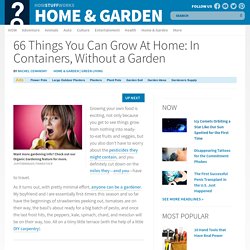
As it turns out, with pretty minimal effort, anyone can be a gardener. My boyfriend and I are essentially first-timers this season and so far have the beginnings of strawberries peeking out, tomatoes are on their way, the basil's about ready for a big batch of pesto, and once the last frost hits, the peppers, kale, spinach, chard, and mesclun will be on their way, too. All on a tiiiny little terrace (with the help of a little DIY carpentry). WATCH VIDEO: World's Greenest Homes: Rooftop Garden. Grow Plants From Your Groceries, Ginger Root, Pineapple, More.
Grow 100 Pounds Of Potatoes In 4 Steps. Container gardening isn’t only for savvy urban gardeners and folks with limited space to grow, it can also be for folks who want to maximize their yields in a controlled environment.

Not only does growing potatoes in a barrel reduce the amount of weeding and exposure to pests and fungi, you don’t even have to risk shovel-damage to the tender potatoes by digging them out of the ground when they’re done, just tip the container over! Grow Potatoes In A Wire Cage. How To Grow Potatoes In A Trash Bag. How To Grow Potatoes In Towers. Growing Fruit In Pots. The Urban Farming Guys. The Urban Farming Guys. Indoor Citrus Trees.
People frequently want to grow some type of fruit tree in a container, usually because of poor soil, improper climate or lack of sufficient space as is often the case around apartments and condominiums.
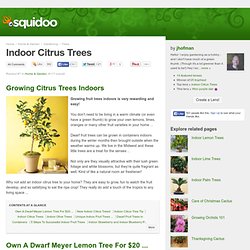
Tips For Growing Fig Trees In Containers. The previous entry touched on advantages of raising fig trees in the backyard, along with a few reasons that make this plant a great option for home gardeners looking to add more fruits to their line up of vegetables. Following are a few tips to help you get started with incorporating fig trees in your backyard by growing them in simple and convenient containers and pots. Planting Stock: Fig trees grow and bear fruit quickly so don’t pay a premium to obtain large starter or mature nursery plants. I’d rather save the cash or purchase more fig trees by choosing younger, smaller sized planting stock.
If you have a friend or neighbor who is growing figs, another option is to take cuttings and propagate new plants that way. Local nurseries sell fig trees and they are also available through mail order and the Internet. Fig Containers: Plastic, clay, even wooden planters or half barrels will do fine for potting up fig trees. D.I.Y. Projects - Micro-Farm. Extreme Urban Gardening: Straw Bale Gardens. Here’s a very simple technique for gardening in tight spots and in places with no/terrible soil (from the arctic circle to the desert to an asphalt jungle). It’s also a great way to garden if you have limited mobility (in a wheel chair). What is Straw Bale Gardening? You simply plant your garden in straw bales. Here’s an example of what a straw bale garden looks like (via author/expert Joel Karsten — he’s got a good book on the topic and he teaches it in seminars) As you can see, the basic technique is actually quite simple.